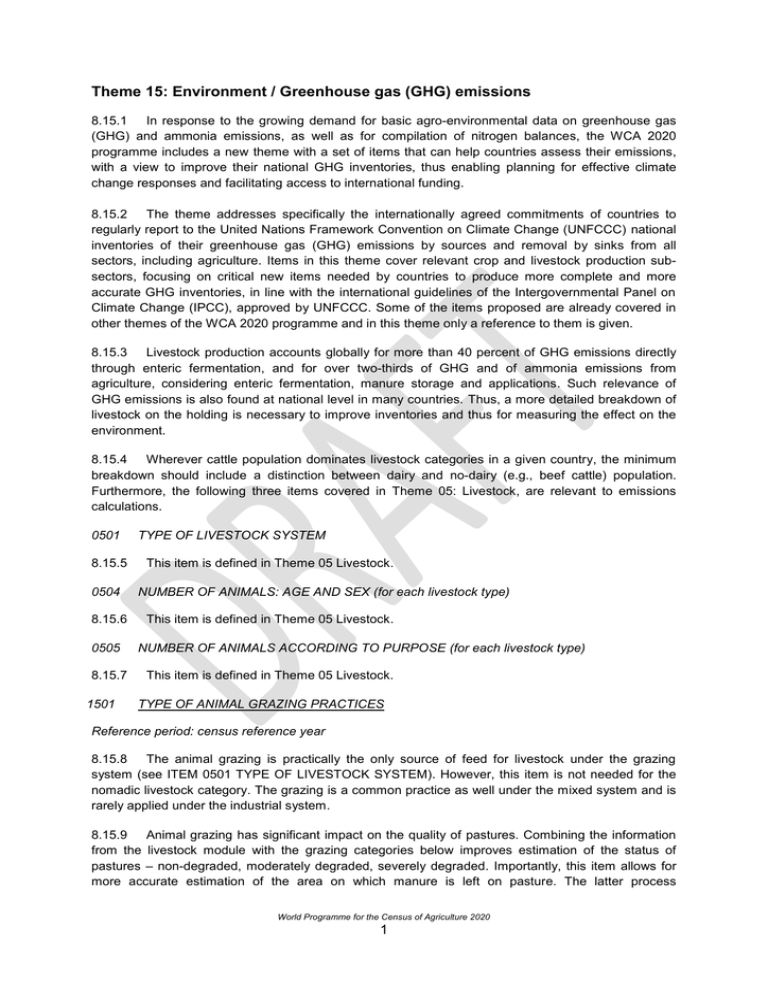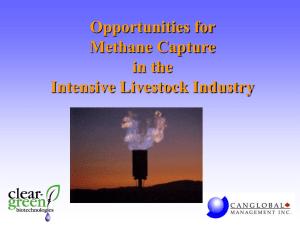DRAFT Theme 15: Environment / Greenhouse gas (GHG) emissions
advertisement

Theme 15: Environment / Greenhouse gas (GHG) emissions 8.15.1 In response to the growing demand for basic agro-environmental data on greenhouse gas (GHG) and ammonia emissions, as well as for compilation of nitrogen balances, the WCA 2020 programme includes a new theme with a set of items that can help countries assess their emissions, with a view to improve their national GHG inventories, thus enabling planning for effective climate change responses and facilitating access to international funding. 8.15.2 The theme addresses specifically the internationally agreed commitments of countries to regularly report to the United Nations Framework Convention on Climate Change (UNFCCC) national inventories of their greenhouse gas (GHG) emissions by sources and removal by sinks from all sectors, including agriculture. Items in this theme cover relevant crop and livestock production subsectors, focusing on critical new items needed by countries to produce more complete and more accurate GHG inventories, in line with the international guidelines of the Intergovernmental Panel on Climate Change (IPCC), approved by UNFCCC. Some of the items proposed are already covered in other themes of the WCA 2020 programme and in this theme only a reference to them is given. 8.15.3 Livestock production accounts globally for more than 40 percent of GHG emissions directly through enteric fermentation, and for over two-thirds of GHG and of ammonia emissions from agriculture, considering enteric fermentation, manure storage and applications. Such relevance of GHG emissions is also found at national level in many countries. Thus, a more detailed breakdown of livestock on the holding is necessary to improve inventories and thus for measuring the effect on the environment. 8.15.4 Wherever cattle population dominates livestock categories in a given country, the minimum breakdown should include a distinction between dairy and no-dairy (e.g., beef cattle) population. Furthermore, the following three items covered in Theme 05: Livestock, are relevant to emissions calculations. 0501 8.15.5 0504 8.15.6 0505 8.15.7 1501 TYPE OF LIVESTOCK SYSTEM This item is defined in Theme 05 Livestock. NUMBER OF ANIMALS: AGE AND SEX (for each livestock type) This item is defined in Theme 05 Livestock. NUMBER OF ANIMALS ACCORDING TO PURPOSE (for each livestock type) This item is defined in Theme 05 Livestock. TYPE OF ANIMAL GRAZING PRACTICES Reference period: census reference year 8.15.8 The animal grazing is practically the only source of feed for livestock under the grazing system (see ITEM 0501 TYPE OF LIVESTOCK SYSTEM). However, this item is not needed for the nomadic livestock category. The grazing is a common practice as well under the mixed system and is rarely applied under the industrial system. 8.15.9 Animal grazing has significant impact on the quality of pastures. Combining the information from the livestock module with the grazing categories below improves estimation of the status of pastures – non-degraded, moderately degraded, severely degraded. Importantly, this item allows for more accurate estimation of the area on which manure is left on pasture. The latter process World Programme for the Census of Agriculture 2020 1 represents the second largest source of GHG agriculture emissions globally, as well as in many countries where livestock is a dominant production activity. 8.15.10 The agriculture census distinguishes between two types of animal grazing: - - Grazing on the holding : . Area grazed during the year; . Number of animals . Fraction of the year with animals on pasture Common pasture grazing: . Number of animals . Fraction of the year with animals on pasture 8.15.11 Common pasture is the land not belonging directly to agricultural holding, but on which common rights apply. In general terms, common pasture is agricultural area owned by a public authority (state, parish, etc.) over which another person is entitled to exercise rights of common, and these rights are generally exercisable in common with others. Pastures which are rented or over which the holder enjoys rights allotted by the parish or other organisation, e.g. common grazing land apportioned on an acreage basis are not included here. 8.15.12 Area grazed during the year means the total area of pastures owned, rented or otherwise allocated to the agricultural holding on which animals were kept for grazing during the reference year. The grazed area can also be harvested by mowing or other means. 8.15.13 Number of animals means the total number of animals of the holding grazed outdoors. If the animals are grazed more than one time during the reference year, they are counted only once. 8.15.14 Fraction of the year with animals on pasture means approximate time for which the animals spent outside on the pasture (owned, rented or otherwise allocated to the agricultural holding or on common pasture) during the census reference year. The fraction is determined regardless of whether they were there also during the night or spent the night indoors. The fraction can be asked as approximate number of months or in time classes: Up to 3 months From 3 to less than 6 months From 6 less than 9 months More than 9 months 8.15.15 Usually, the time with animals outside on the pasture is the same for holdings practicing animal grazing in a given area. Thus an expert estimate or small sample of holdings would give the necessary information. 1502 MANURE APPLICATION Reference period: census reference year 8.15.16 This item is relevant for the calculation of agri-environmental indicators and particularly for GHG and ammonia emissions. It is not applicable to holdings with nomadic livestock system (ITEM 0501 TYPE OF LIVESTOCK SYSTEM). - Percentage of holding’s pastures on which the manure is left on pasture by livestock (this category is not necessary if items on animal grazing are included) Fraction of manure left on pasture that is removed for use as fuel . Nothing is removed World Programme for the Census of Agriculture 2020 2 . . . Up to 50 percent More than 50 percent but not all All manure is removed Agricultural area on which solid/farmyard manure is applied (spread) Agricultural area on which slurry is applied (spread) Manure directly daily spread on the field - (see definitions in paragraph 8.15.19) 1503 MANURE MANAGEMENT SYSTEM Reference period: census reference year 8.15.17 This item is relevant for the calculation of agri-environmental indicators and particularly for GHG and ammonia emissions. It is not applicable to holdings with nomadic livestock production system (ITEM 0501 TYPE OF LIVESTOCK SYSTEM) - Availability of storage facilities for: . Solid/farmyard manure . Liquid manure . Slurry - Type of storage facilities used: For all manure: . Digesters (biogas reactors) For slurry: . slurry tank . anaerobic lagoon . Aerobic treatment - Are the storage facilities covered? . for solid/ farmyard manure . for liquid manure . for slurry 8.15.18 Cases may exist when in one holding there are both covered and open storage facilities of the same type. Where feasible, information on the percentage of the facilities’ capacity covered could be asked. 8.15.19 For the purpose of the agriculture census, the following definitions will be used: - Solid/farmyard manure is excrements (with or without litter) of domestic animals, possibly including a small amount of urine. Liquid manure is urine from domestic animals, possibly including a small amount of excrement and/or water. Slurry is manure in liquid form, a mixture of excrements and urine of domestic animals, possibly including water and/or a small amount of litter. Manure removed for use as fuel is dried dung cakes created and burned for fuel. Directly daily spread means the manure is routinely removed from the confinement facility and is applied to cropland or pasture within 24 hours of excretion, no storage is needed. Storage facility for solid/farmyard manure usually means a three sided, rectangular or square structure with a concrete floor and reinforced concrete or timber walls. The floor can slope towards the open side where seepage/drainage (liquid fraction) from the stacked solid manure World Programme for the Census of Agriculture 2020 3 - - - - 1504 is collected in a gutter and stored separately. A heap or stack of solid manure stored in a field prior to spreading is excluded. Storage facility for liquid manure / slurry usually means watertight tank, open or covered, or a lined lagoon for storage of liquid manure/slurry. Slurry tank is a tank, usually made of impermeable material, used for the storage of slurry. Watertight pits or cellars beneath/integrated in the livestock houses are also included. Anaerobic lagoon is a pit dug in the soil, usually lined, used for the storage of slurry. Anaerobic lagoons are designed with varying lengths of storage, depending of the climate region, the volatile solids loading rate and other operating factors. The water from the lagoon may be recycled as flush water or used to irrigate and fertilise fields. Aerobic treatment is the biological oxidation of manure collected as a liquid with either forced or natural aeration. Natural aeration is limited to aerobic and facultative ponds and wetland systems and is due primarily to photosynthesis. Hence, these systems typically become anoxic during periods without sunlight. Storage facilities for manure are considered covered (with e.g. concrete lid, tent, tarpaulin, etc.) when they are protected from rain or other precipitation and the cover can reduce ammonia emissions. Digester (biogas reactors) is a reactor where animal excreta with or without straw and/or other materials such as wood shavings, sawdust, etc are collected and anaerobically digested in a large containment vessel or covered lagoon. Digesters are designed and operated for waste stabilisation by the microbial reduction of complex organic compounds to CO 2 and CH4, which may be captured and flared or used for energy production. FINAL USE OF THE TREATED MANURE Reference period: census reference year 8.15.20 This item refers to percentage use of manure exiting the manure management system, and is applicable to all holdings with land and to landless holdings with non-nomadic type of livestock system (ITEM 0501 TYPE OF LIVESTOCK SYSTEM). - applied as fertiliser; for fuel; for construction; feed; other. 8.15.21 For the purpose of the agriculture census, final use for fuel refers to manure used for production of energy. Manure left on pasture, collected and dried for dung cakes burned for fuel is not reported here but under Item 1502 MANURE APPLICATION. Final use for construction means that manure is used as a component for preparing construction materials. “Other” are those uses not mentioned in the previous categories, such as manure exported from the holding. Often the manure is sold or given for free to others for fertilizer. 0411 USE OF EACH TYPE OF FERTILIZER 8.15.22 This item is covered in Theme 04: Crops. Use of fertilizers and their type is relevant for the calculation of GHG and ammonia emissions. 0412 AREA FERTILIZED FOR EACH TYPE OF FERTILIZER AND MAJOR CROP TYPE 8.15.23 This item is covered in Theme 4: Crops. Use of fertilizers and their type is important for the calculation of GHG and ammonia emissions. World Programme for the Census of Agriculture 2020 4 Sub-Module on Rice Cultivation 8.15.24 Rice cultivation accounts for ten percent of global GHG emissions in agriculture, but is significantly higher in rice producing countries. The following items are relevant to improve the accuracy of estimates of GHG emissions from rice cultivation. 1505 LENGTH OF THE GROWING PERIOD FOR RICE CULTIVATION Reference period: census reference year 8.15.25 Length of the growing period means number of months between crop planting and harvest. 1506 RICE CULTIVATION - IRRIGATION AND WATER REGIMES Reference period: census reference year 8.15.26 This item complements the information collected in Item 0305 AREA IRRIGATED FOR EACH CROP TYPE defined in Theme 03 “Irrigation and water management” (see paragraphs 8.03.15-8.03.16), specifically for rice irrigation and water regimes. It is a holding-level item. However, for operational reasons, countries may find it easier to collect the data at field/plot level as one holding could have different water regimes for different fields. - Water regimes before the growing period: . Flooded pre-season . Non-flooded pre-season 8.15.27 Flooded pre-season means that the land has been flooded for at least 30 consecutive days or more just prior to planting. 8.15.28 Non-flooded pre-season means that the land has been flooded less than 30 consecutive days or has not been flooded prior to planting. - Water regimes during the growing period relative to continuously flooded fields: . Irrigated – continuously flooded . Irrigated – intermittently flooded . Rice cultivation in rainfed and deep water area 8.15.29 Irrigated – continuously flooded is a field that has standing water throughout the rice growing period and may only dry out for harvest (end-season drainage). 8.15.30 Irrigated – intermittently flooded is a field that has at least one aeration period of more than 3 days during the growing period. 8.15.31 Rice cultivation in rainfed and deep water area means rice grown on levelled bunded fields to allow an accumulation of flood water on the surface during heavy rains, grown in areas that depend entirely on rain for moisture for its water supply. Deep water areas for rice cultivation are usually flooded deeper than 50 cm for 1 month or longer during the growing season. 1507 ORGANIC AMENDMENTS TO SOILS USED FOR RICE CULTIVATION Reference period: census reference year 8.15.32 In addition to the information already asked in Item 0412 AREA FERTILIZED FOR EACH TYPE OF FERTILIZER AND MAJOR CROP TYPE in Theme 04 Crops (see paragraph 8.04.46), the World Programme for the Census of Agriculture 2020 5 following further breakdown of the organic fertilizers used gives an important information about the rice cultivation practices. - Straw incorporated shortly before cultivation (thirty days or less) Straw incorporated long before cultivation (more than thirty days) Compost Farmyard manure Green manure 8.15.33 Straw incorporated shortly before cultivation (thirty days or less) means that straw is incorporated to soil no longer than 30 days before the cultivation of rice. 8.15.34 Straw incorporated long before cultivation (more than thirty days) means that straw is incorporated to soil longer than 30 days before the cultivation of rice. 8.15.35 Compost is a mixture of decaying organic substrates, as from leaves and manure, used to improve soil structure and provide nutrients. Alternatively: organic substrates subject to biological decomposition and stabilization and converted in a final product that is stable, free of pathogens and plant seeds, and can be beneficially applied to land (Haug, 1993). 8.15.36 Solid/farmyard manure - see paragraph 8.15.19. 8.15.37 Green manure/cover crops (GMCCs) are plants that are grown in order to provide soil cover and to improve the physical, chemical, and biological characteristics of soil. GMCCs may be sown independently or in association with crops (FAO, 2011). 1508 CROP RESIDUES Reference period: census reference year 8.15.38 Management and use of crop residues may affect the environment. This item is applicable to all farms. - Crop/pasture area burnt on the holding Crop residues removed from field Pastures on the holding renewed during the crop year 8.15.39 Crop/pastures area burnt on the holding, refers to the area of crop/pastures where crop residues/grass are burnt during the reference year. The case when the residues were being gathered up and burnt in a pile on or off the fields the residue came from are also included here. 8.15.40 Crop residues can be straw, stubble or other plant parts leaving good mulch that remain from the previous harvest. 8.15.41 Crop residues removed from field is the fraction of crop residues which is not left on the field. This information only refers to those crop fields that are not burned. 8.15.42 Pastures on the holding renewed during the crop year, is the area of pastures that is ploughed and seeded to have a new grass cover. This information does not include the area of pasture renewed by fires, which is to be reported as “Crop/ pastures burnt on the holding”. 8.15.43 Where feasible, information on areas should be collected. World Programme for the Census of Agriculture 2020 6 1509 PERMANENT CROPS - AGE OF PLANTATIONS Reference period: day of enumeration 8.15.44 Item 0406 AREA OF PRODUCTIVE AND NON-PRODUCTIVE PERMANENT CROPS IN COMPACT PLANTATION (for each permanent crop type) in Theme 04 “Crops” (see paragraphs 8.04.26 – 8.04.30) asks for area by permanent crop type. 8.15.45 In addition to item 0406, for the purpose of improving estimates of GHG emissions by sources or removals by sink, the following information from farms with commercial orchards is needed: 0610 Ages of plantations (productive and non-productive) Age at which the permanent crops are renewed TYPE OF TILLAGE PRACTICES 8.15.46 This item is defined in Theme 06 “Agricultural practices”: Item 0610 TYPE OF TILLAGE PRACTICES (see paragraphs 8.06.28-8.06.32). World Programme for the Census of Agriculture 2020 7






